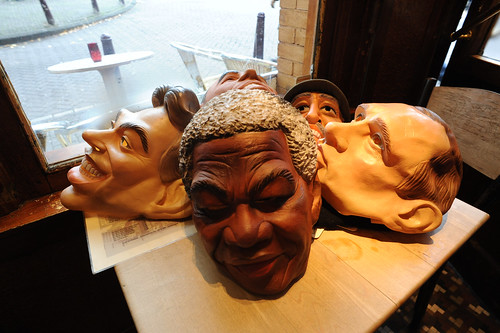While rummaging through a stack of things read and to-be re-read, I came back across this curious paper by Mark Blythe and Peter Wright called “Pastiche Scenarios: Fiction as a Resource for Experience Centred Design”. I believe I was referred to while deep into this business of “design fiction.” It describes an approach to design that employs scenarios that draw from pre-existing stories, particularly stories that have characters whose sensibilities, styles, quirks, etc., are well-rehearsed in the larger cultural milieu. You know — existing players from existing stories. The full design fiction production notes come from the things I learn from clever story tellers who actually do design fiction. Combining props as fictional design objects that are almost secondary to the experience that people have — like Hitchcock’s Macguffin’s that move a story forward, but now the story also has fleshed out fictional characters who have a large set of pre-existing attributes put together in a way that only a good story teller could accomplish.
I find this quite intriguing, particularly because most of the user scenarios or user segmentation models and demographic architectures rely on quite flat personas. They are not really people so much as database files of characteristics, demographics, and rather flat “marketing” grammars — the kind of car they are likely to drive, career aspirations, disposable incomes. This sort of thing.
As opposed to this, the idea of using an existing character to fill out the design thinking exercises may not produce better design, but it may produce more effective design communication. This is mostly what I am thinking about here — mechanisms for communicating an idea. This to me is not about strategies for devising clever new experiences — crackerjack designers should be able to do this from their own experiences and capabilities which is what makes a crackerjack designer crackerjack. It may be that bad design comes from poor design instincts. But it likely also comes from poor communication of intent and sensibility, which results in the loss of integrity and foundational principles of a design, which gets mucked up in the execution. Which includes all the objectives that cloud that integrity, such as, for example, accounting and profit principles.
From Pastiche scenarios: fiction as a resource for experience centred design.
Rather than attempt to write strong character-based scenarios from scratch we have looked to re-use characters from existing fictions. Characters such as Ebenezzer Scrooge and Bertie Wooster Bridget Jones and Renton from Trainspotting. This has the advantage of drawing on readers’ shared knowledge of already familiar characters thereby recruiting a pre-existing rich understanding of the character-users and the use context. If you have read Dickens’ Christmas Carol or Bridget Jones’s diary you will have an understanding of these characters and be able to envision how they would respond to new and novel situations. This is so because giving the reader such an understanding is precisely the point of a well-written novel. If you have not read these novels there are so many other cultural representations of the characters in film and television that they will still resonate. And if you have never seen any of them they are strong enough on the page to make an impression at first reading.
Pastiche scenarios can be used as rhetorical devices for design – to convince and persuade and to make apparent assumptions and values around the design and use of technology. They can also be used to explore emotional, social and political contexts of use. Characters in fiction can occasionally surprise their own authors..When characters with as much depth and richness..are recruited to scenarios they might also surprise and inform designers. The use of complex, rounded characters may also create ambiguity which, as Gaver et all (2003) note, can lead to new design challenges and insights.
Related of course is critical design in the sense of creating provocations, to stir discussion and consideration of things, although critical design does not have as its primary purpose the creation of things.
Critical design is related to haute couture, concept cars, design propaganda, and visions of the future, but its purpose is not to present the dreams of industry, attract new business, anticipate new trends or test the market. Its purpose is to stimulate discussion and debate amongst designers, industry and the public about the aesthetic quality of our electronically mediated existence. It differs too from experimental design, which seeks to extend the medium, extending it in the name of progress and aesthetic novelty. Critical design takes its medium social, psychological, cultural, technical and economic values, in an effort to push the limits of lived experience not the medium. This has always been the case in architecture, but design is struggling to reach this level of intellectual maturity. [Design Noir: The Secret Life of Electronic Objects]
Critical design would seem to be preliminary to the communication, to stir conversations that help yield some insights into the design itself.
Why do I blog this? Rehearsing strategies for communicating the intent of designed things using something other than bullet points and four-quadrant graphics and up-and-to-the-left graphs. But I also wonder how these two curious practices can come together in a fruitful way. Current mood: Hopeful.
